12 Vintage Advertising Clocks That Tell More Than Time
Advertising clocks once did more than mark the hours. They drew eyes to shop windows, brightened diners, and reminded people of their favorite brands. From soda counters to gas stations, these timepieces blended function with charm. Today, collectors treasure them for their color, nostalgia, and stories from another time.
This post may contain affiliate links, which helps keep this content free. Please read our disclosure for more info.
Coca-Cola Bubble Clock (1950s–60s)

These round bubble-front wall clocks became symbols of American soda culture during the mid-20th century. Found in diners and corner stores, their curved plastic faces glowed softly behind the red Coca-Cola script. They were easy to spot across a room and created a friendly atmosphere that invited customers to linger. Many collectors prize them for their nostalgic design and warm retro light.
The clocks were often produced by companies like Pam Clock or Telechron, which specialized in lighted advertising displays. Their electric movements were reliable, and their sturdy housings helped many survive decades of use. Some versions featured slogans like “Drink Coca-Cola” or colorful bottle images. Each surviving piece feels like a small window into America’s soda-fountain past.
Pepsi-Cola Neon Clock (1940s–50s)
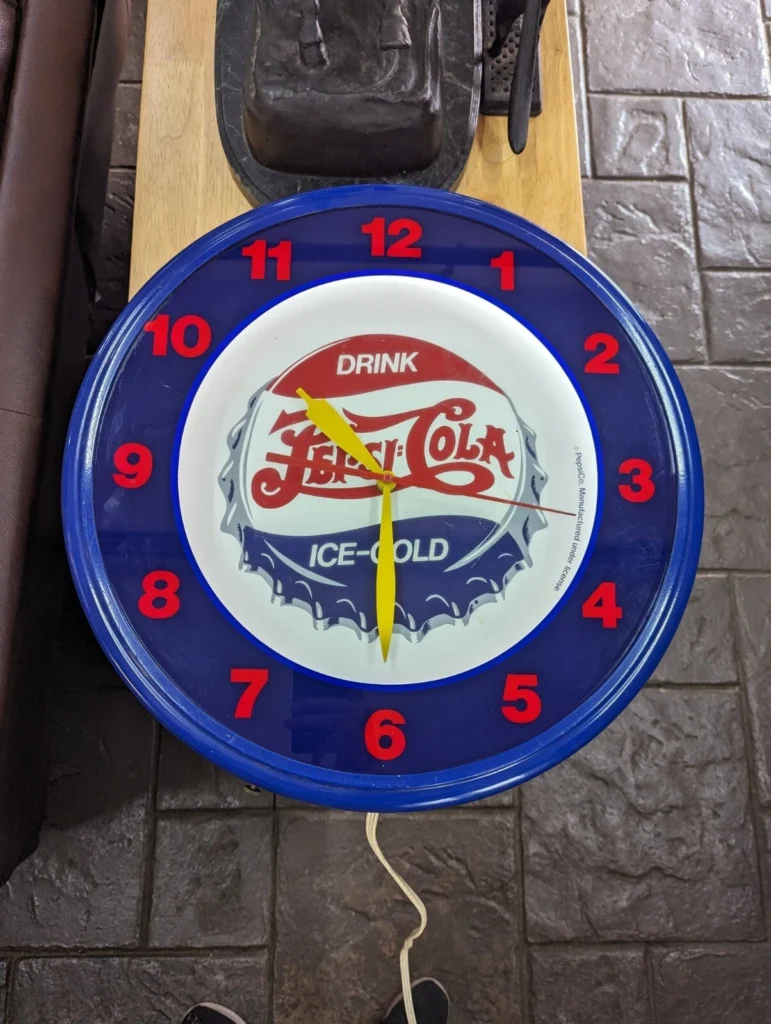
Pepsi’s neon clocks glowed with cool blue rings and vivid lettering that stood out against chrome frames. They were meant to catch the eye of anyone driving by a roadside diner or gas station. The design carried the optimism of postwar advertising, when color and light were key to drawing customers inside. Their smooth hum and gentle neon flicker now charm collectors and vintage fans alike.
Most were made for regional bottlers, so each one can have slight differences in text or layout. Some feature slogans like “More Bounce to the Ounce” or the double-dot Pepsi logo that came before the modern globe. Neon tubing required maintenance, so working originals are now rare. When restored, they make a statement piece that still feels fresh decades later.
Budweiser Clydesdale Light-Up Clock (1970s)
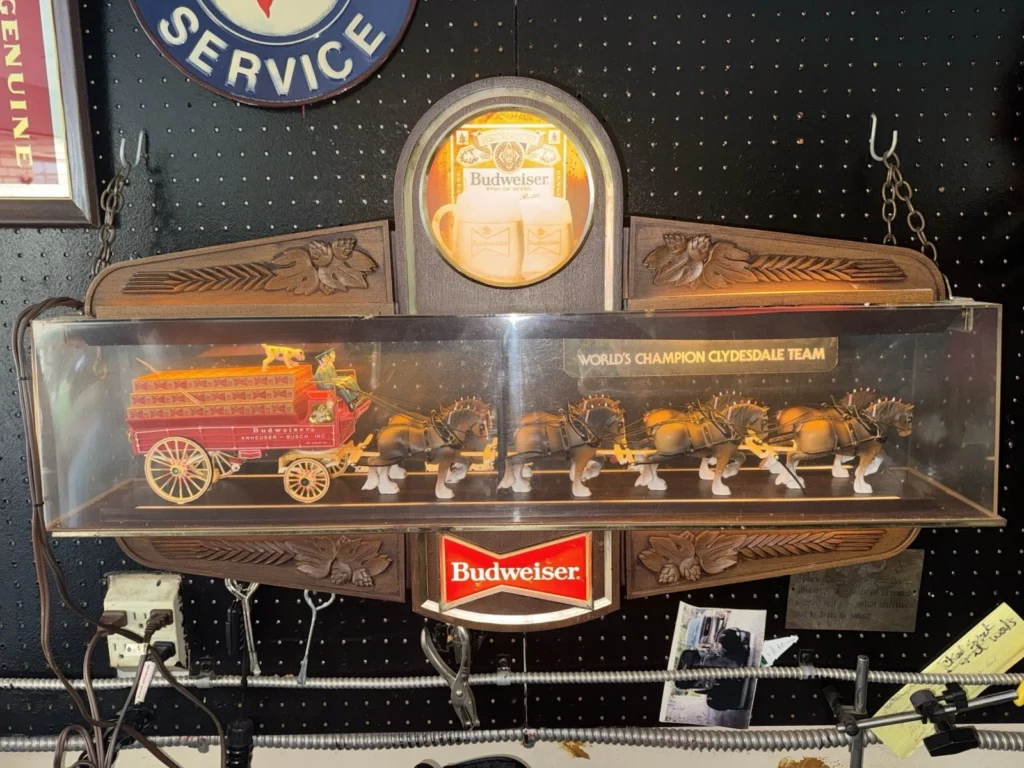
These clocks celebrated Budweiser’s iconic Clydesdales, often showing them in motion with a rotating or backlit display. Beer distributors hung them in bars and taverns, where they added warmth and movement to dim interiors. Their plastic panels and glowing gold accents matched the beer’s branding perfectly. Few clocks combine nostalgia and brand storytelling as well as these.
The mechanisms were simple, yet their animated scenes drew attention even when the lights dimmed. Collectors often look for versions with the full team of horses and wagon, which tend to be more valuable. Their mix of Americana and motion art keeps them in demand among both beer and advertising enthusiasts. They remain a favorite example of how a brand turned timekeeping into entertainment.
7-Up Swinging Pendulum Clock (1960s)
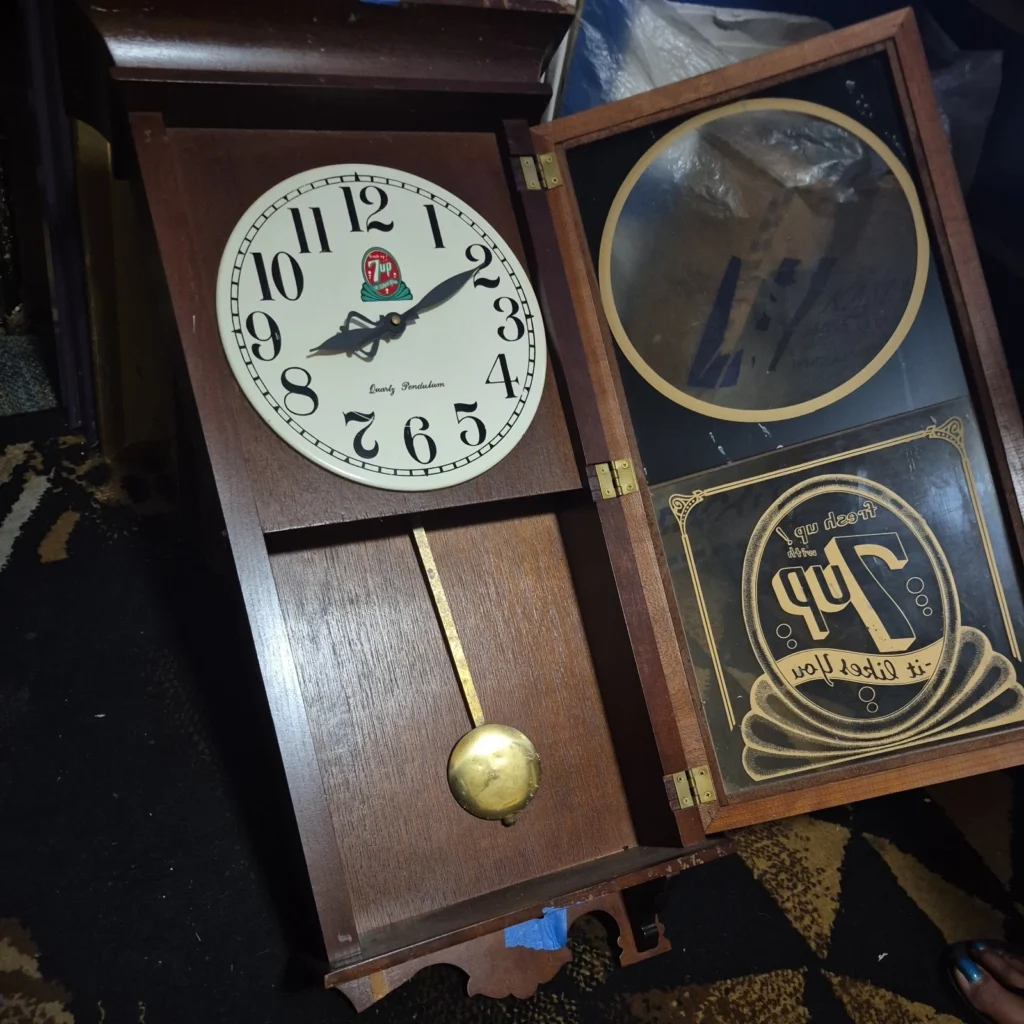
This cheerful clock featured a pendulum shaped like a 7-Up bottle cap, swinging gently below a bright face. It was playful and modern, fitting right in with the mid-century kitchen and soda shop style. The clock’s white and green color palette echoed the brand’s bubbly and lighthearted personality. It reminded shoppers that refreshment was only a few steps away.
Collectors love the motion feature that gives these clocks a touch of personality. Many models were made by Pam or Swihart, known for their high-quality advertising clocks. The pendulum action often wears with age, so working examples are treasured. Their simple charm continues to brighten walls and bring a smile to those who remember the soda’s heyday.
Texaco Star Oil Clock (1940s)

Texaco clocks once hung proudly in service bays and waiting rooms, showing off the red star that stood for trust and reliability. Built with metal casings and glass faces, they could handle grease, heat, and heavy shop wear. The clean white backgrounds and bold logos made them instantly recognizable. They were functional tools that quietly reinforced brand loyalty.
Today, these clocks symbolize early American automotive culture. Many collectors find them appealing for their industrial look and sturdy construction. Original examples with porcelain faces and electric movements are especially valuable. Their timeless design reminds viewers of an era when gas stations were neighborhood landmarks.
Sinclair Dino Clock (1950s)
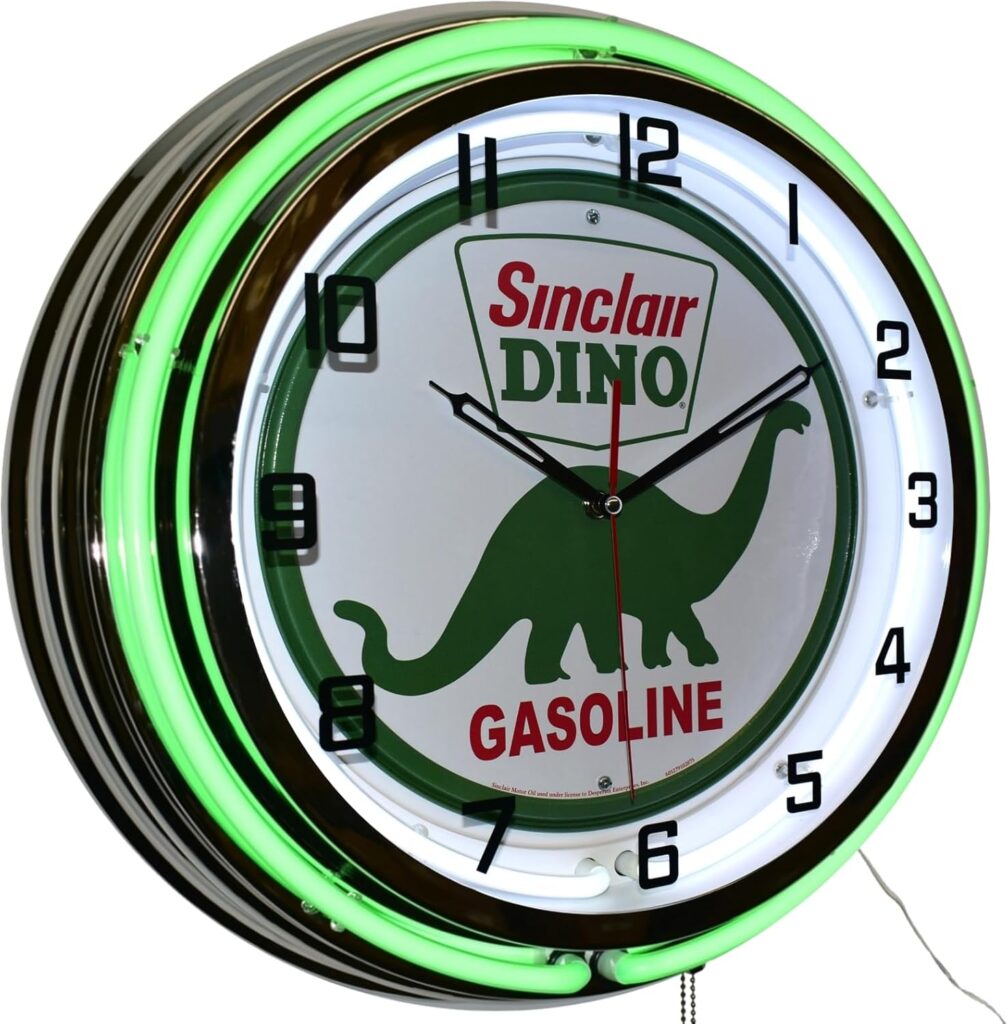
The friendly green dinosaur logo made the Sinclair Dino clock stand out among other oil company displays. Often found above cash registers or on service walls, its bright design appealed to both adults and kids. The playful mascot added a friendly face to a practical business. These clocks helped make the brand memorable in an era filled with roadside competition.
Most models featured painted metal frames and electric movements built to last. The design tied into Sinclair’s national advertising campaign that linked oil to prehistoric origins. Collectors enjoy them for their mix of humor, design, and durability. A working Dino clock brings a splash of fun to any vintage garage or office.
Phillips 66 Shield Clock (1950s)

The orange and black shield of Phillips 66 made a striking logo, and on a clock face, it became even more eye-catching. These timepieces hung in gas stations where customers could check the time while getting a fill-up. Their bold design mirrored the adventurous spirit of America’s open roads. Few logos from that era have aged as gracefully.
Collectors often find variations that include slogans or different shield shapes, depending on regional distributors. Many still feature original neon or fluorescent tubing that highlights the logo at night. Their mix of function and brand power makes them a standout in roadside memorabilia collections. Restored pieces glow again, just as they did along the highways of the 1950s.
RC Cola Lighted Clock (1950s)

RC Cola’s lighted clocks added color and style to diners and grocery counters. Their bubble-glass faces and chrome edges reflected the brand’s cheerful image. The gentle hum of their electric bulbs became part of the shop atmosphere. For many, they were reminders of an underdog soda with loyal fans.
These clocks came in limited runs, making them rarer than Coke or Pepsi models. Some included rotating bottle images or slogans like “Best by Taste-Test.” Working examples are prized for their vibrant glow and nostalgic appeal. They continue to represent the charm of small-town soda culture.
Hamm’s Beer Scene Clock (1960s)

Hamm’s clocks were famous for their moving scenes that depicted waterfalls, forests, and shimmering lights. Combined with the cartoon bear, they turned a basic clock into an eye-catching piece of bar décor. The motion created a relaxing rhythm that matched the “From the Land of Sky Blue Waters” slogan. People often found themselves watching longer than they meant to.
Their internal motors powered both the animation and the clock mechanism, making maintenance tricky but rewarding. Collectors seek versions with smooth motion and bright color scenes intact. When restored, these clocks fill a room with soft light and playful motion. They remain one of the most beloved pieces in beer advertising history.
Dr Pepper “10-2-4” Clock (1940s)

This clock promoted Dr Pepper’s unique idea of drinking a soda at 10, 2, and 4 o’clock each day for a pick-me-up. The simple round face featured those times marked boldly, reminding customers when to treat themselves. It was clever, catchy, and effective. Shops and pharmacies proudly displayed these clocks to spark sales.
The advertising message has since become a cultural reference for collectors and brand historians. Early models featured glass fronts and tin frames, often painted in cream and red. Restored versions bring back the charm of postwar marketing. The Dr Pepper clock still stands as a playful example of how timing became part of a product’s story.
Mobil Pegasus Clock (1950s)
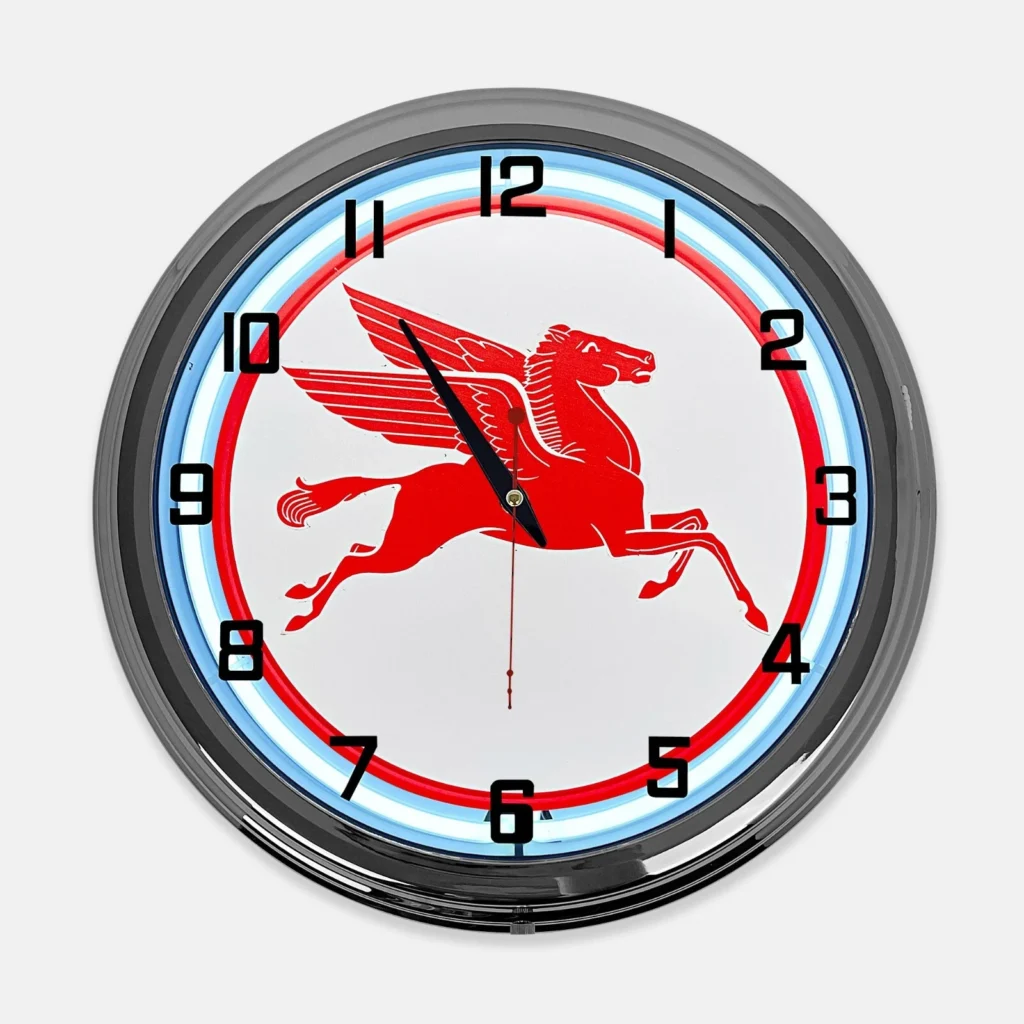
The red Pegasus logo in flight graced Mobil’s wall clocks with elegance and energy. Many hung in service stations and offices where their design added a touch of sophistication. The polished metal frames and clean faces made them stand out against plain shop walls. Even without neon, they carried a quiet glow of professionalism.
Collectors appreciate their minimalist beauty and connection to postwar design trends. Some versions include embossed glass or subtle backlighting that highlights the winged horse. They remain favorites among petroliana enthusiasts for their style and craftsmanship. Each clock carries the image of speed, motion, and mid-century confidence.
Vernor’s Ginger Ale Soda Fountain Clock (1930s)
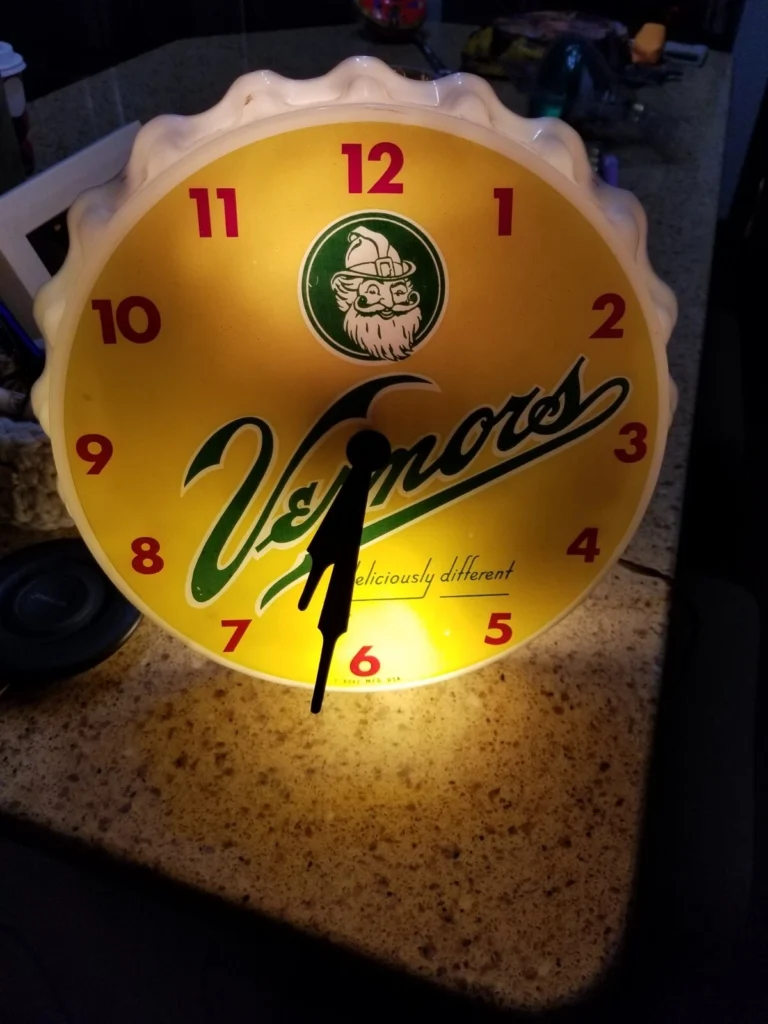
Vernor’s clocks captured the cheerful tone of the classic Detroit ginger ale. With bright yellow faces and Art Deco lettering, they brought color to soda fountains and lunch counters. The brand’s mascot, the gnome, often appeared nearby in ads or displays. The clocks reminded customers that a frosty glass of ginger ale was always a good idea.
Made during the early electric advertising boom, they’re now rare finds for collectors. Many show the hand-painted details and stylized fonts of the 1930s design era. Their vintage glow and regional pride appeal to fans of old American brands. Each one tells a little story about soda culture in the Great Lakes region.
This article originally appeared on Avocadu.
